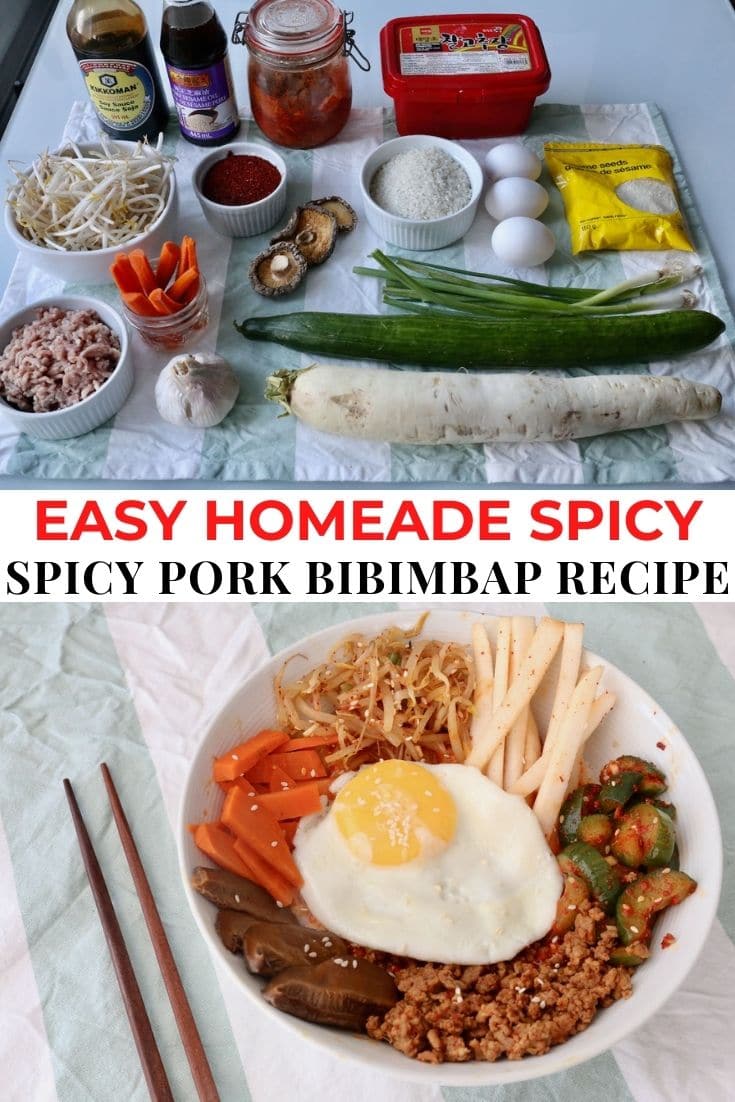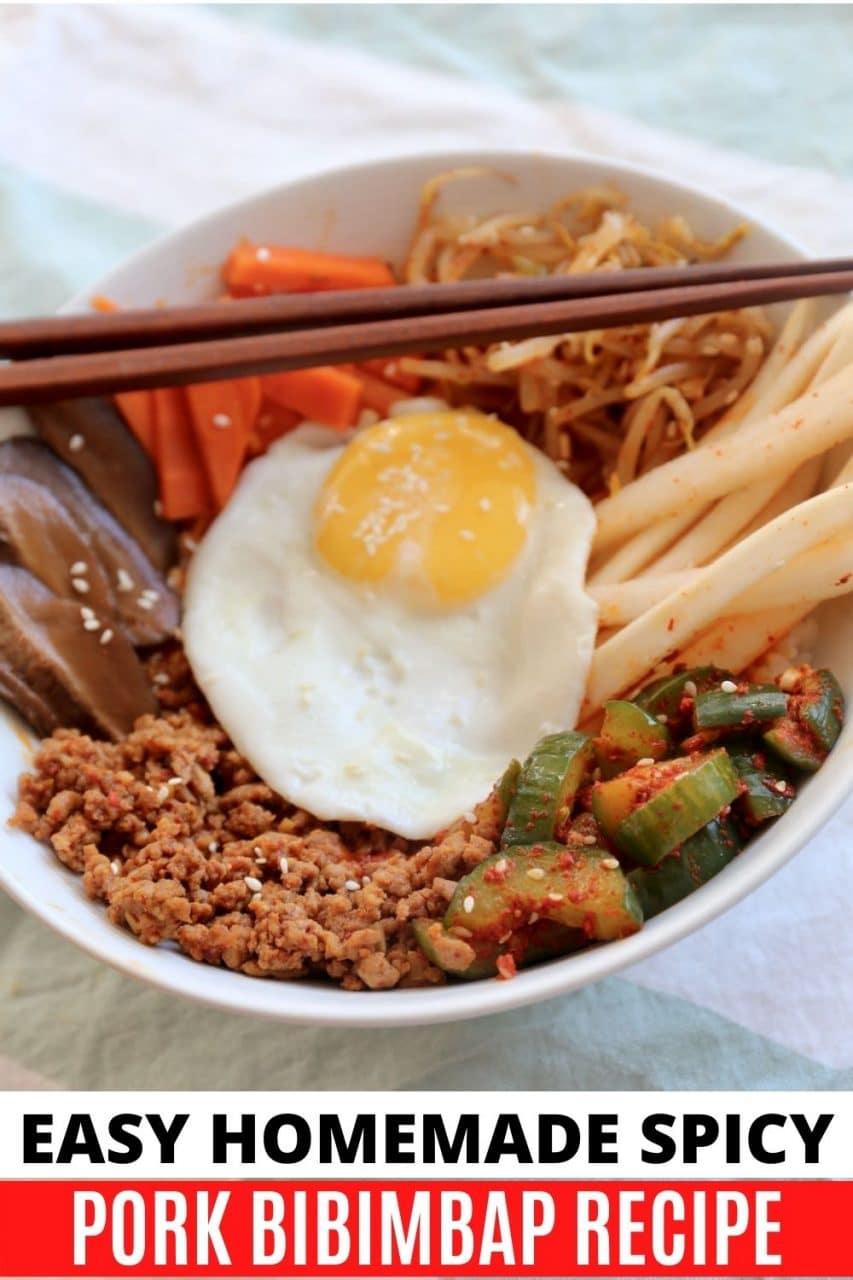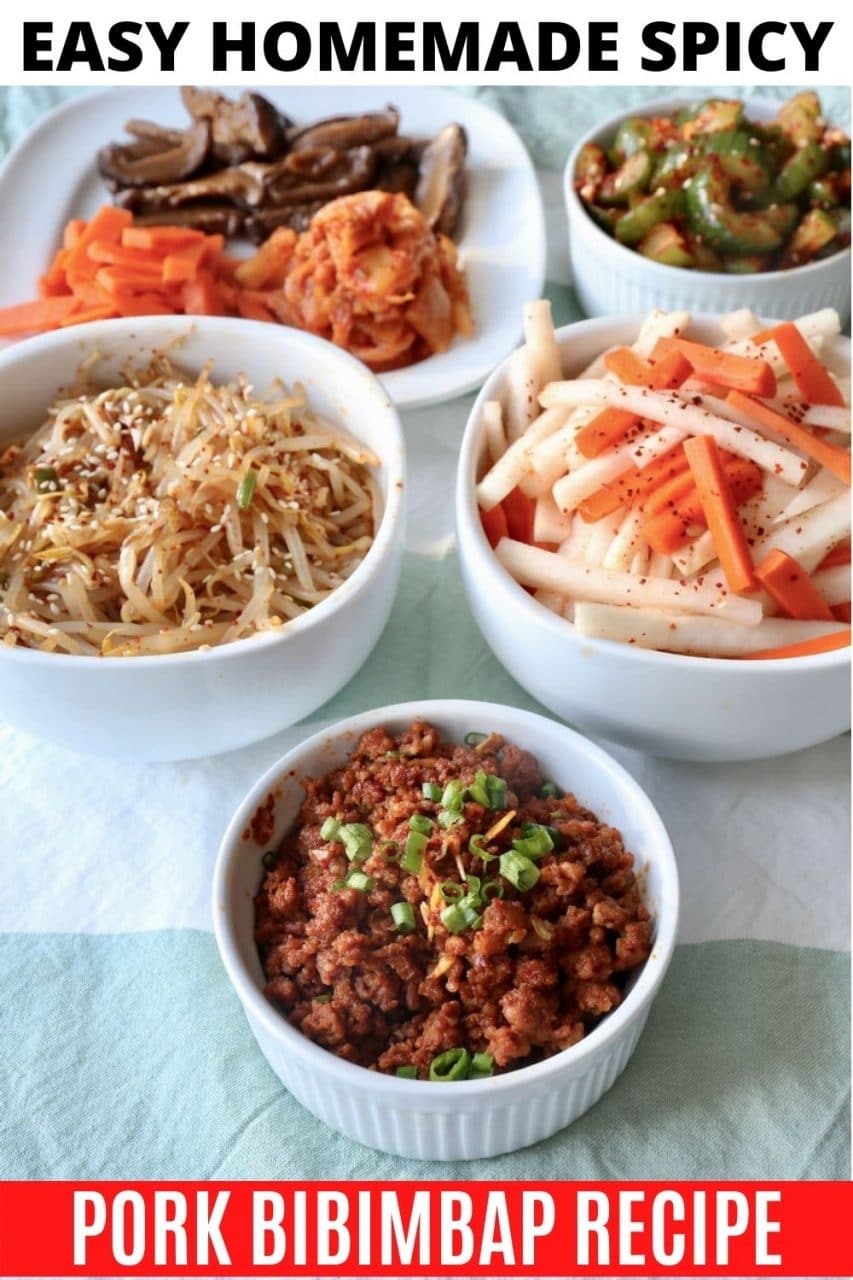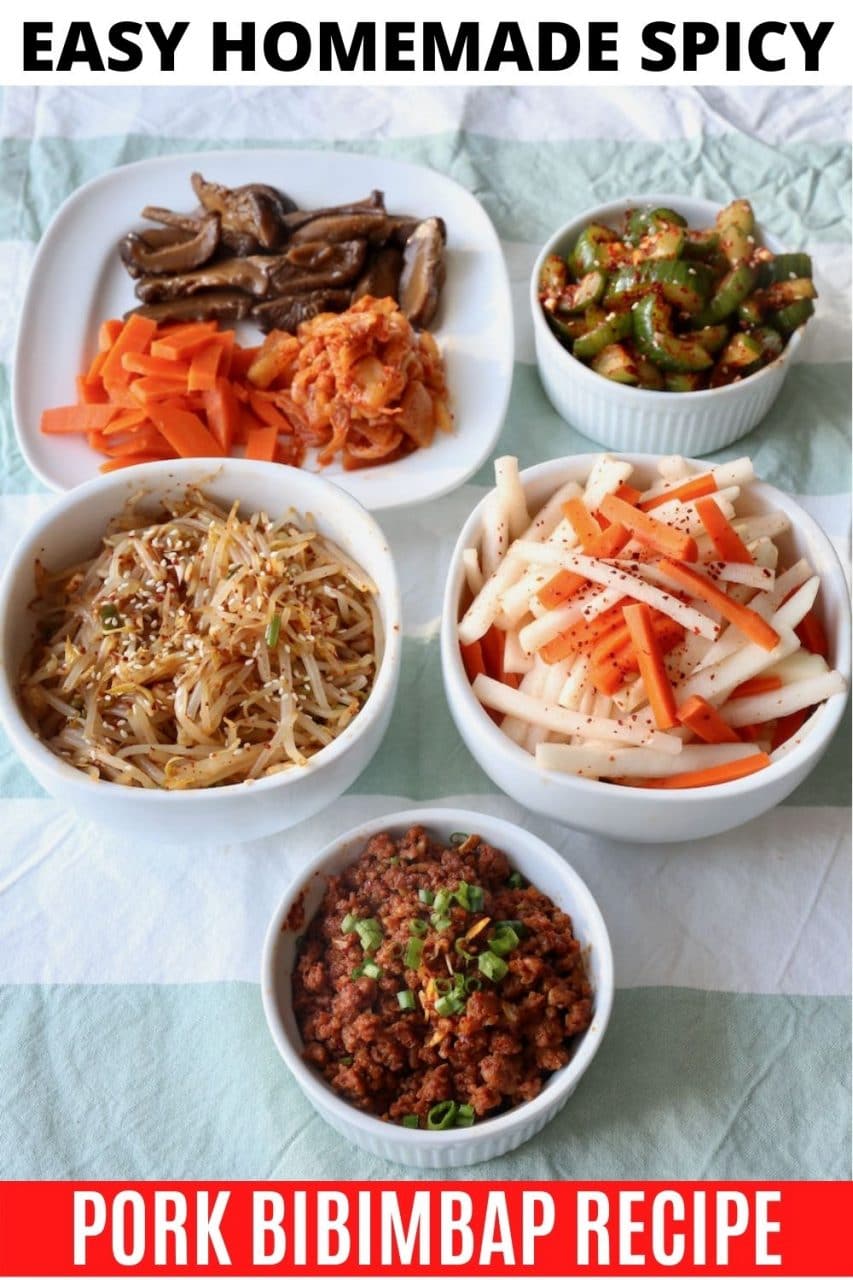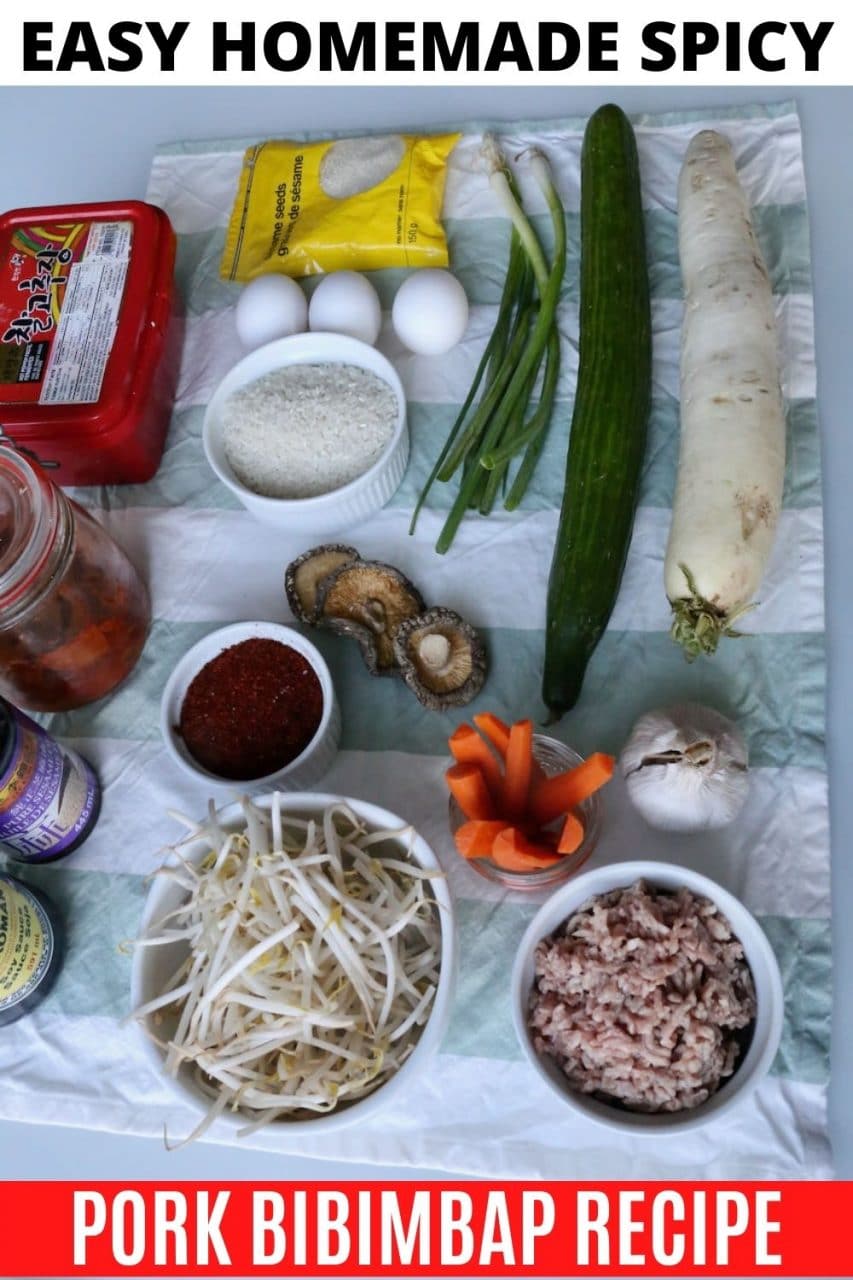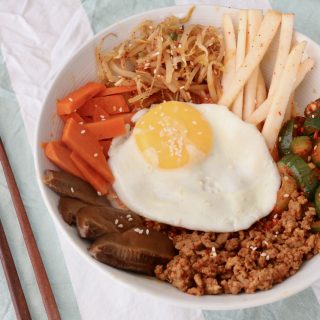Spicy Pork Bibimbap is one of our favourite Korean recipes to cook at home in the Fall and Winter.
Bibimbap is one of Korea’s national dishes, literally translating to “mixed rice.”
Our version of the classic recipe is topped with spicy Korean minced pork. It’s quick and easy to make, ready to serve in under 1 hour.
You’ll love spooning through a bowl of our homemade Pork Bibimbap recipe featuring crunchy carrots, spicy Korean radish, sautéd cucumber, marinated bean sprouts, fried mushrooms, homemade kimchi, sunny side up egg and toasted sesame seeds.
Save This Story To Pinterest!

What Is Bibimbap?
Bibimbap is one of Korea’s national dishes, literally translating to “mixed rice.” The name in English is often romanized as bi bim bap or bi bim bop.
The origin of the many names of bibimbap come from its hanja or Chinese based records. Originally appearing in yokjokumun of kijae-jabki by Park in the end of 16th century. The historical record associated original bibimbap recipes as hondonban, which later went on to become bubuiembap nearly 200 years later.
The first known recipe for bibimbap is found in the Siuijeonseo, an anonymous cookbook from the late 19th century. In the late 20th century, bibimbap started to become widespread in many countries in the West, due to its simplicity, cheap cost, eye-popping appeal and yummy taste.
Many airlines connecting to South Korea via Incheon International Airport began to serve bibimbap, and it was accepted more globally as a popular Korean dish. Bibimbap has also been described as a symbol of the Korean culture to non-Koreans and became especially trendy during the 2018 Winter Olympics in PyeongChang.
The term “bibim” means mixing various ingredients, while the “bap” noun refers to rice. Bibimbap is an inherently customizable food with a variety of ingredients that can be used in its creation. It came from early rural Koreans taking leftover vegetables, sometimes having meat, with rice and mixing them in a bowl. This was cheap and didn’t require all of the time and space of a traditional meal.
Bibimbap is served as a bowl of warm white rice topped with namul (sautéed and seasoned vegetables) and kimchi (traditional fermented cabbage) and gochujang (chili pepper paste), soy sauce, or doenjang (a fermented soybean paste). A raw or fried egg and sliced meat (marinated beef or pork) are common additions.
The dish is traditionally served in a hot stone bowl and stirred together thoroughly just before eating using chopsticks and a spoon.
Today bibimbap is one of the most affordable dishes to eat in Korea. Vegetarian versions of the dish can often be found at hole-in-the-wall restaurants for under $2 USD.
Our favourite rendition of classic Korean rice recipe is Spicy Pork Bibimbap, which we’ll show you how to cook today!
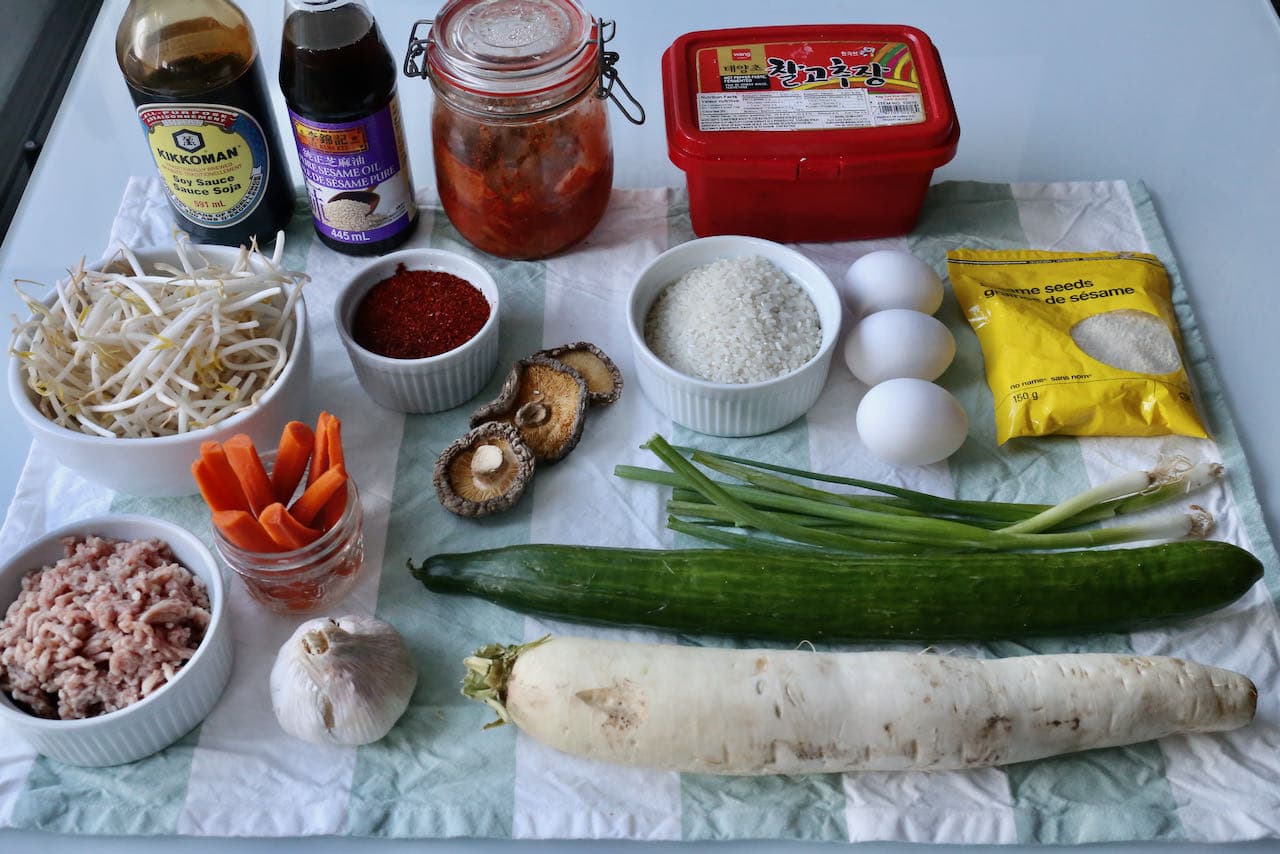
Travel to Korea by Cooking Pork Bibimbap at Home
I love traveling through Asia.
As a professional food and travel writer I’ve eaten my way through India, Maldives, Japan, Hong Kong, Macau, Philippines, Indonesia, Malaysia, Singapore, Cambodia, Myanmar, Thailand, Vietnam and Laos.
My first visit to Asia had me living in South Korea for a year as an English teacher. That’s when I was first introduced to yummy fermented vegetables like kimchi.
In Korea, I’ve spooned through many steaming bowls of Spicy Pork Bibimbap at restaurants in Seoul, Suwon, Busan, Samcheok, Jeju and even the North Korean DMZ.
My first time eating bibimbap was almost immediately after getting off the plane in Seoul. I spent my first week in Korea attending intensive teacher training classes. Whenever we’d break for lunch they’d serve Pork Bibimbap with a few noodle dishes and banchan.
After spending a year living in Korea and traveling across the country I ate hundreds of bibimbap Korean rice bowls.
Our authentic Pork Bibimbap recipe is a spicy Korean rice dish featuring crunchy carrots, spicy Korean radish, sautéd cucumber, marinated bean sprouts, fried mushrooms, homemade kimchi, sunny side up egg and toasted sesame seeds.
After enjoying your first few spoonfuls, you’ll realize why a sizzling bowl of traditional Pork Bibimbap is a must-try when visiting South Korea!
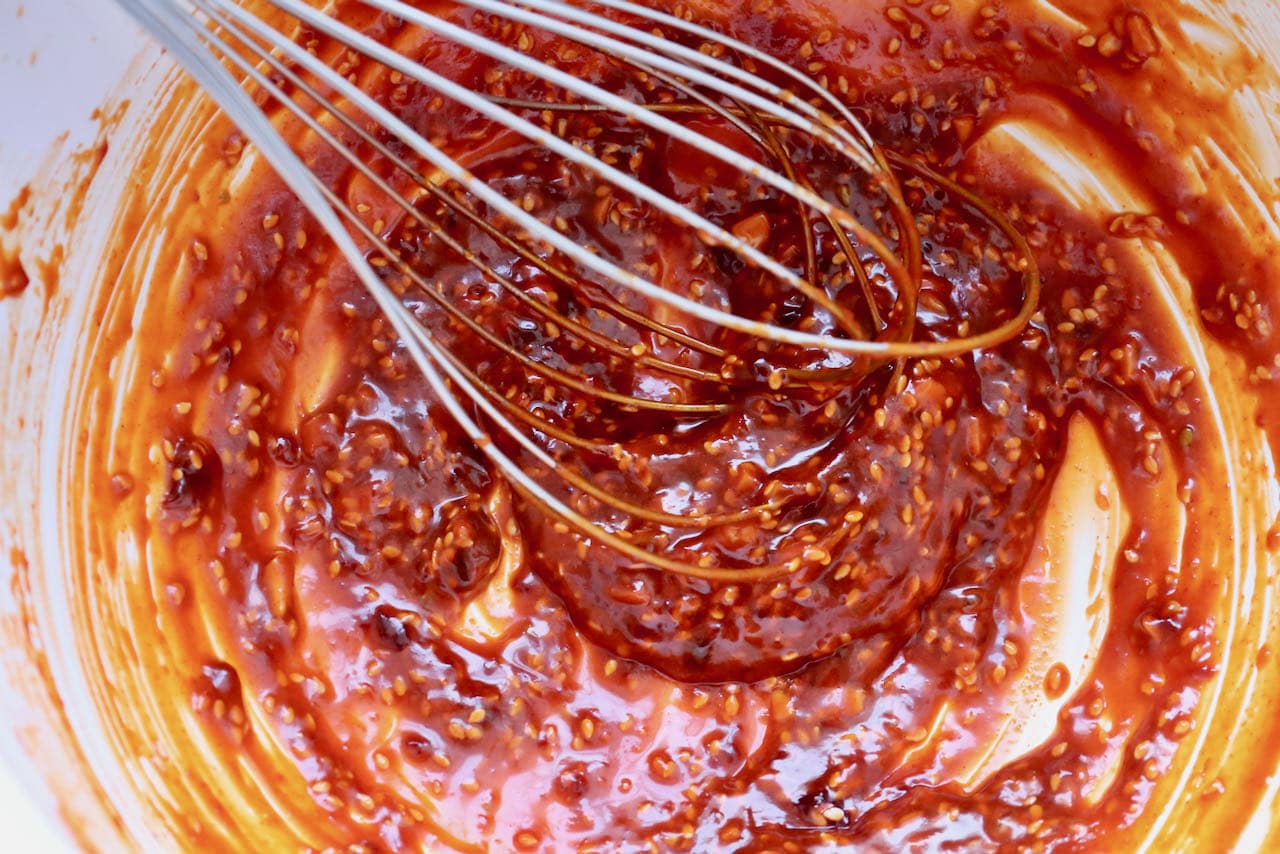
Where To Eat Traditional Spicy Pork Bibimbap
If you live in a large city in Canada or America you’ll likely have access to a local Korean restaurant that serves traditional Pork Bibimbap.
Haven’t traveled to Korea before? It may be helpful to first sample authentic Spicy Pork Bibimbap at a local restaurant to better understand how it is served. You’ll get an idea for the ideal spice level, number of vegetables to serve on top of each bowl and the perfect rice to minced pork ratio.
You’ll also find inspiration on what to pair with Pork Bibimbap including Korean inspired dishes like Gochujang Chicken Wings, Ssamjang Chicken and Jjajangmyeon.
In Toronto, popular Korean restaurants the may serve Pork Bibimbap include Doma, Korean Village Restaurant, Arisu, Charcoal and Salt, Koko Share Bar, The Owl of Minerva, Seoul Shakers, Té Restaurant, Barrio Coreano, Momofuku Noodle Bar, Tofu Village and Korea House.

My Family Loves Spicy Pork Bibimbap
My parents flew to Asia to visit me on holiday during my 12 months in Seoul. Before landing at Incheon they visited Tokyo and Kyoto in Japan.
They had never been to a Korean restaurant at home in Toronto or Oakville before so every dish was a surprise to their taste buds.
It’s no secret that my dad is a picky eater so I was a little nervous about him finding commonplace menu items like raw fish, spicy soup and fatty samgyeopsal to be unappealing.
Thankfully my parents both fell in love with Pork Bibimbap. They ordered the dish many times during visits to Insadong and Dongdaemun. They enjoyed mixing together the perfectly steamed rice, fresh vegetable toppings, oozing fried egg and flavourful pork.
Korean Bibimbap is the ideal “kitchen sink” recipe to prepare last minute for dinner when trying to use up old vegetables in your fridge and ground pork in the freezer.

Pork Bibimbap Health Benefits
Our easy homemade Pork Bibimbap recipe is packed full of healthy ingredients!
Onions are a humble vegetable packed with vitamins, minerals and phytochemicals. Regular consumption of leeks can help boost digestive health and reduce the risk of developing heart disease.
It is only recently that scientists have begun to identify the components responsible for garlic’s myriad health benefits. Rich in phytochemicals and potassium, garlic helps boost your immune system, fight cancer and protect your heart.
A useful source of copper, calcium, manganese, and phosphorus, sesame seeds help support circulatory, digestive and skeletal health.
Mushrooms are rich in B vitamins: riboflavin, niacin, and pantothenic acid. The combination helps protect heart health.
An excellent source of vitamin A and the phytochemical beta-carotene, carrots help keep your eyes and bones healthy, and may help protect against several types of cancer.
An excellent source of vitamins K and C, cabbage helps keep your bones, blood, and immune system healthy.
Kimchi, a fermented cabbage condiment in Korea, is considered one of the healthiest foods on earth. The nutrient dense food features vitamin A and C, 10 different minerals and 34 amino acids.
Eggs contain two vital nutrients that are not present in many foods: iodine and vitamin D. Eggs are also rich in tissue-building protein and vitamin B12, which helps your body manufacture blood cells.
Pork is an excellent source of protein and provides several important vitamins and minerals. It’s an excellent source of thiamin, selenium, niacin, vitamin B-6 and phosphorus, zinc, riboflavin and potassium.
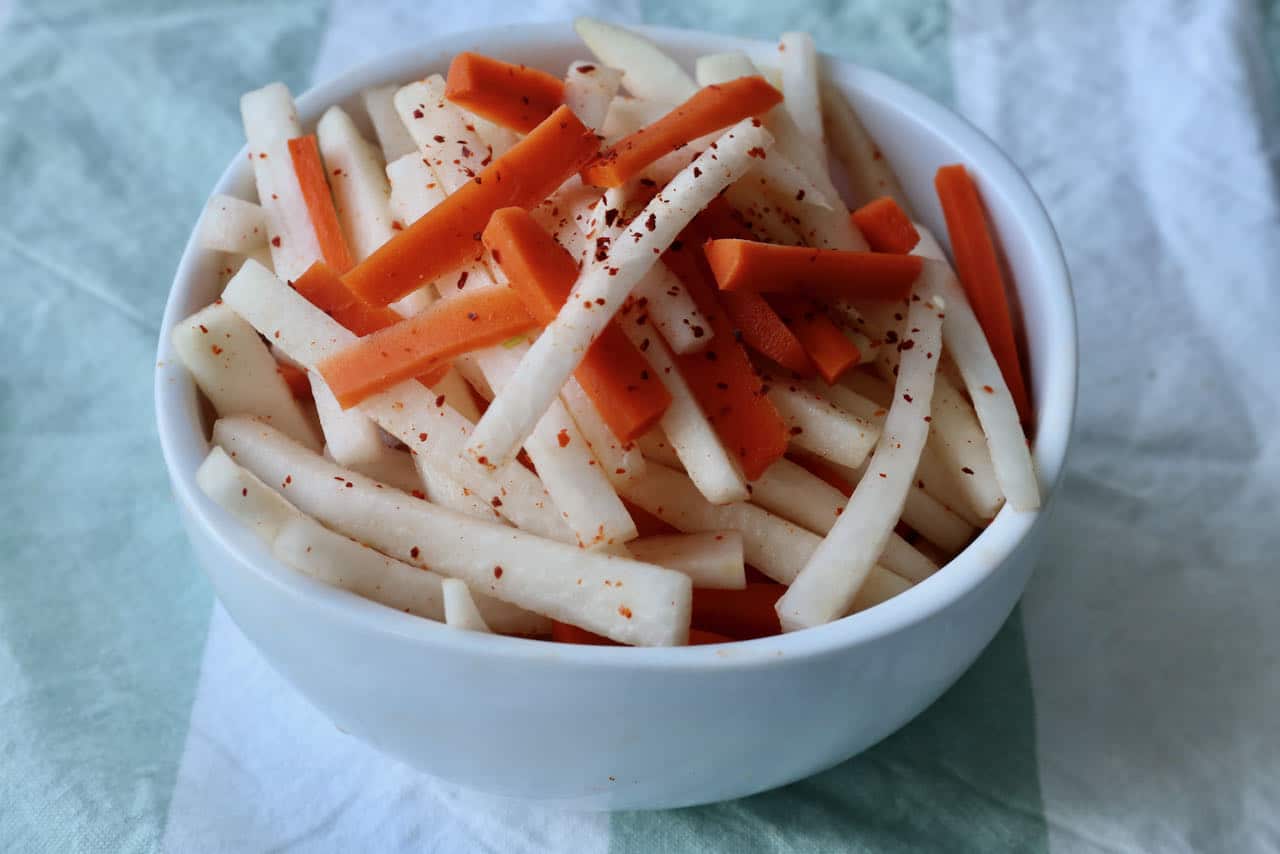
Homemade Pork Bibimbap Tips
This healthy Pork Bibimbap recipe is quick and easy to make at home. We’ve included a few tips for first time bibimbap cooks!
- Since we wanted to make share an easy pork bibimbap recipe we used minced meat. You can also barbecue pork chops or roast pork tenderloin and then slice the meat thinly and add it to your Korean rice bowl.
- The main ingredient for Bibimbap sauce is gochujang, Korean fermented red pepper paste, a staple in Korean cooking. You must use gochujang when preparing authentic spicy pork bibimbap. If you can’t find it at your local grocery store visit an Asian supermarket or purchase on Amazon.
- Koreans typically use short grain white rice for this dish. If you want to make this Korean rice bowl even healthier, use short grain brown rice or mixed grain rice instead.
- If you’d like to make the recipe extra spicy, feel free to add additional kimchi, Korean red pepper powder, birds eye chili or a few dashes of your favourite hot sauce.
- Ssamjang is a sweet fermented bean paste. You can reduce heat and add a sweet flavour profile by adding a few teaspoons.
- We’ve topped our Korean rice bowl with a sunny side up egg but it’s very common in Korean to have a raw egg yolk on the top that you mix into the hot rice. Feel free to try both cooking methods.
- Once you’ve mastered our Pork Bibimbap recipe feel free to get creative with your toppings. Other popular bibimbap banchan include seasoned spinach, steamed eggplants and watercress namul.

How To Make Vegetarian or Vegan Bibimbap
Making a vegetarian or vegan bibimbap is simple! Just leave out the meat and egg.
A few vegetable toppings taste great and tofu is a popular meat substitute. Pan-frying the tofu enhances the flavour of the tofu and gives it a desirable chewy texture
If you have homemade vegetarian or vegan kimchi, slice it up as it is a nice addition to a healthy Korean rice bowl.
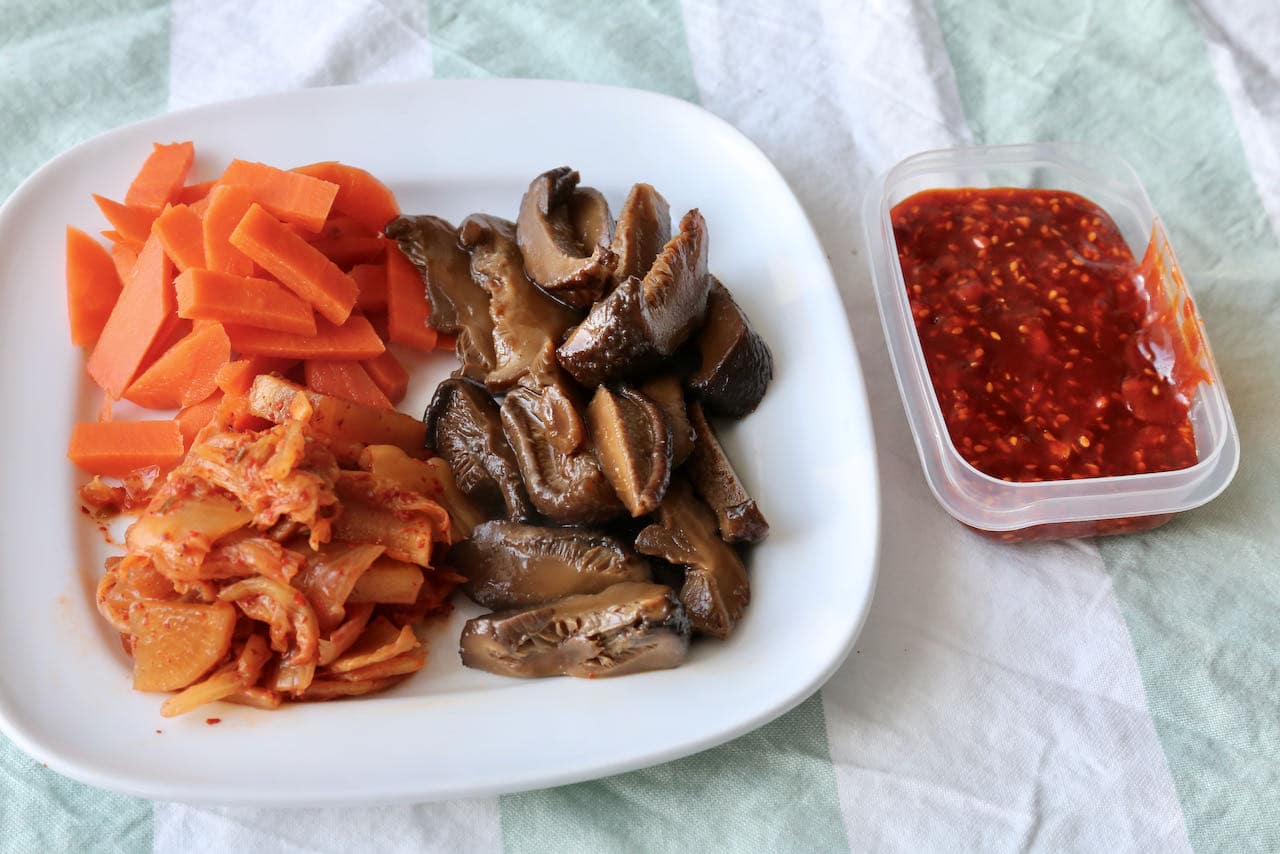
What To Serve with Spicy Pork Bibimbap
There’s nothing more comforting on a cold day then cozying up to a bowl of Spicy Pork Bibimbap.
If you’re hosting a large dinner party you might want to serve small bowls or Pork Bibimbap as an appetizer before serving heartier mains.
We love eating Korean Rice Bowls with Chinese Cucumber Salad, Osaka Okonomayaki, Calgary Ginger Beef, Green Onion Cake, Vietnamese Crepe Bánh Xèo, Gochujang Chicken Wings and Ssamjang Chicken. Serve our recipe with your favourite craft beer, fine wine or cocktails.
After dinner why not dazzle your guests with one of our popular desserts such as Oat Flour Cookies with Chocolate Chips, Dark Chocolate Lindt Lindor Cookies, Maraschino Cherry Cupcakes Recipe or Cinnamon Babka For Chocolate Lovers.
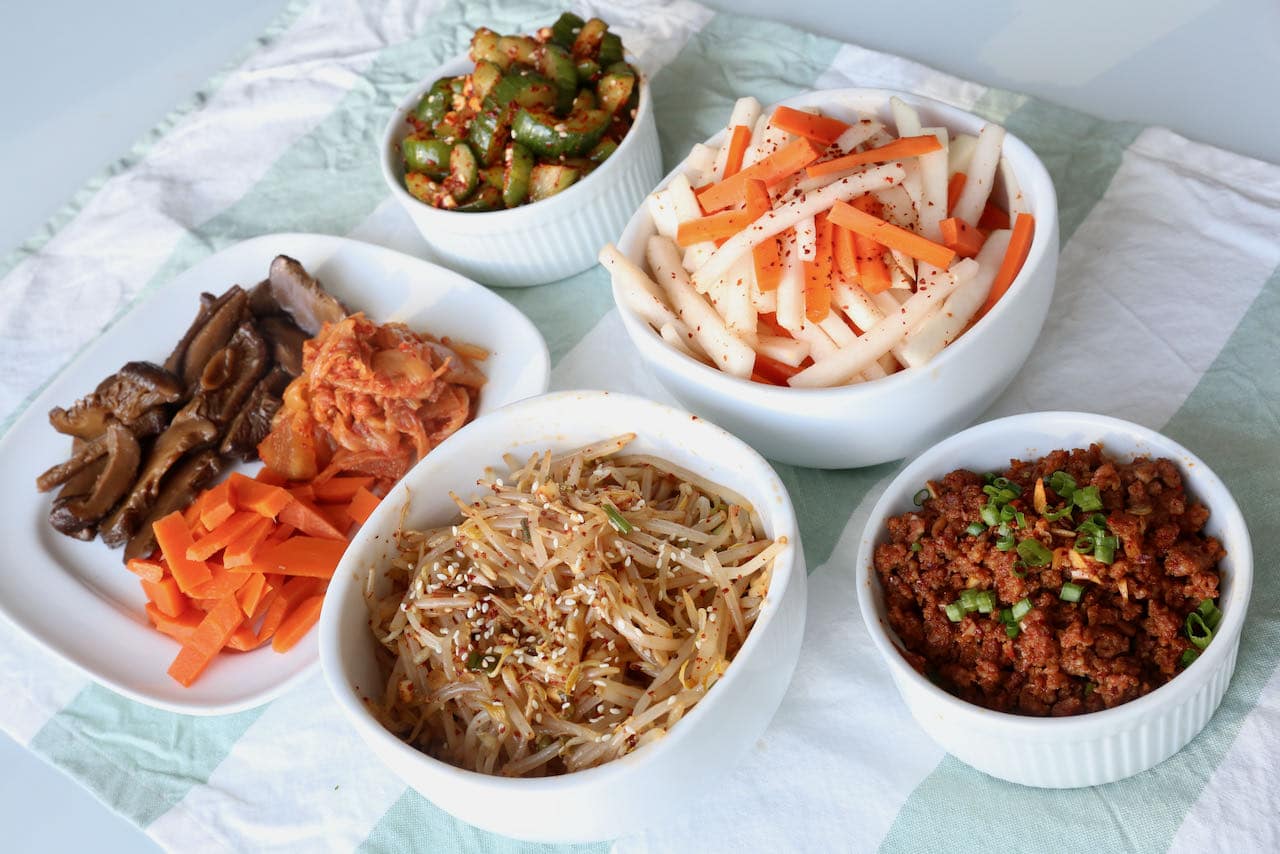
You May Also Enjoy Reading…
- Roasted Beetroot Salad with Grapefruit, Pistachio and Herbed Cream
- Mizeria Creamy Polish Cucumber Salad Recipe
- Goi Xoai Vietnamese Mango Salad Recipe
- Quick & Easy Indian Onion Salad Recipe
- Guasacaca Sauce: Venezuelan Guacamole Recipe
- Easy Creamy Warm Orzo Lemon Salad
- Easy Healthy Homemade Goi Ga Vietnamese Salad
- Easy Healthy Roasted Vegetable Couscous Recipe
- How To Make Healthy Sweet Potato Rice
- How To Make The Best Canadian Salad Recipe
- Healthy Garlic Lemon Chickpea Avocado Salad
- Grabong Northern Thai Pumpkin Fritter Recipe
- Gai Pad Med Mamuang Thai Cashew Chicken Recipe
- Gaeng Masaman: Authentic Massaman Curry Recipe with Beef
- Nam Tok Authentic Thai “Waterfall Beef” Salad Recipe
- Gaeng Keow Wan: Thai Green Curry Chicken Recipe
- Bun Cha Recipe: Healthy Vietnamese Noodle Bowl
- Thai Pork & Beef Mince Curry Khua Kling Recipe
- Authentic Chiang Mai Noodles “Khao Soi” Recipe
- Easy Pad Kra Pao Thai Basil Stir-Fry Recipe
- Best Laos Papaya Salad Tum Mak Hoong Recipe
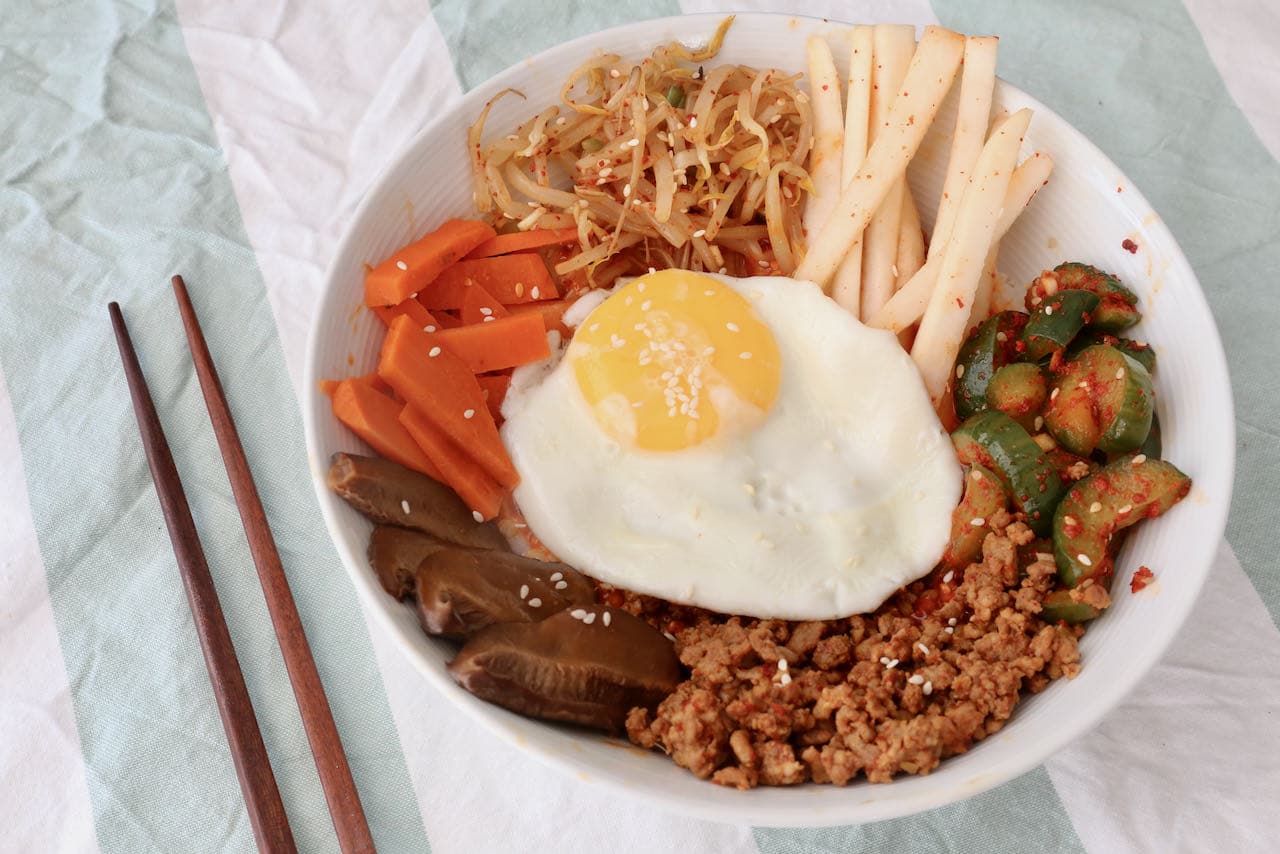
Storing Bibimbap
If you have leftover Bibimbap you can store it in the fridge in an airtight container for 2-3 days. We suggest storing all of the prepared ingredients in separate small Pyrex containers so you can assemble a few Korean rice bowl for lunch or dinner later.
To reheat simply zap it in the microwave or warm the ingredients in the oven.
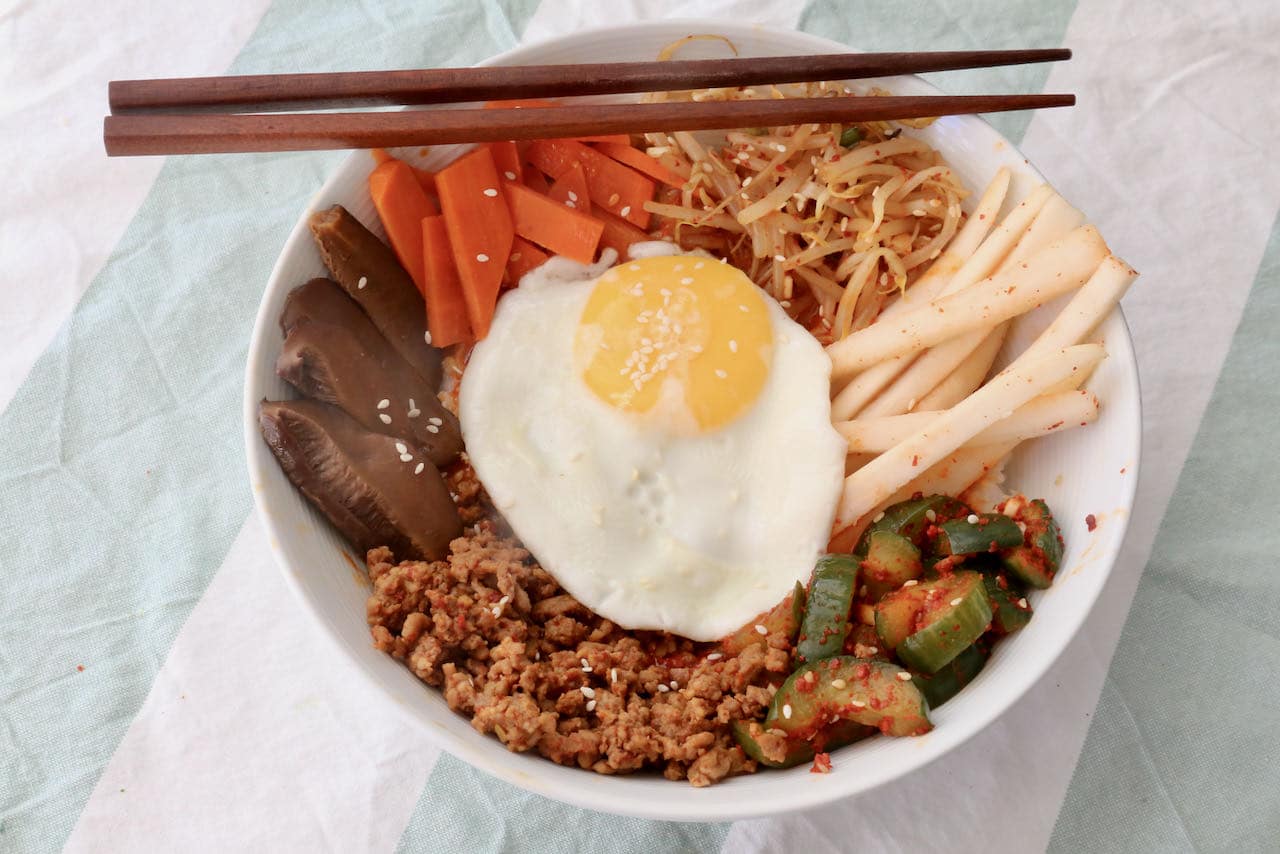
How To Make Spicy Ground Pork Bibimbap
Spicy Pork Bibimbap
Ingredients
Marinated Pork
- 200 g Minced Pork
- 1 tbsp Soy Sauce
- 1 tbsp Sesame Oil
- 1 tsp Sugar
- 2 Garlic cloves minced
- 2 tsp Gochujang
Bibimbap Sauce
- 2 tbsp Gochujang
- 1 tbsp Sesame oil
- 1 tbsp Sugar
- 1 tbsp Sesame Seeds
- 1 tsp Vinegar
- 2 Garlic cloves minced
Quick Spicy Cucumber Pickles
- 1 lb English Cucumber
- 1.5 tsp Salt
- 1 tbsp Gochugaru Korean Chile Flakes
- 1 tsp Vinegar
- 1 tsp Sesame Oil
- 2 tsp Sugar
- 1 tsp Sesame Seeds
- 1 Garlic clove minced
Sweet & Sour Radish (Musaengchae)
- 1 lb Daikon Korean Radish
- 1 Small carrot
- 3 tbsp Vinegar
- 2 tbsp Sugar
- 1/2 tsp Salt
- 1/4 tsp Gochugaru Korean Red Chili Pepper Flakes
Korean Spicy Sprouts (Kongnamul Muchim)
- 1 lb Soybean Sprouts
- 1 Scallion chopped
- 1 Garlic clove minced
- 1 tbsp Sesame oil
- 1 tsp Sesame seeds
- 1/2 tsp Salt
- 1 tsp Gochugaru Korean Red Chili Pepper Flakes
- 1 tbsp Soy Sauce
Bibimbap Garnish
- 100 g Shiitake Mushrooms
- 1 Carrot julienned
- 3 cups Steamed Korean Rice
- 4 Eggs
- 1/4 cup Kimchi
Instructions
- BIBIMBAP SAUCE: Mix bibimbap sauce ingredients in a bowl until fully incorporated. Set aside.
- CUCUMBERS: Halve cucumbers lengthwise and scoop out the seeds. Chop the cucumbers into 1/2-inch pieces. Put the chopped cucumbers in a colander set over a large bowl. Sprinkle the cucumbers with the salt and toss them gently to combine. Let the cucumbers sit for 30 to 60 minutes. The salt will draw out water from the cucumbers. After they've rested, squeeze them firmly to get even more water out of them. Do this in small handfuls to be the most effective. Lay the cucumber pieces on a clean kitchen towel or rolls of paper towels and roll up the towels tightly around the single layer of cucumbers to squeeze even more water out of the cucumbers. Put the cucumbers in a medium bowl. Add the garlic, pepper flakes, rice vinegar, sesame oil, and sugar. Toss everything to combine thoroughly. Sprinkle the sesame seeds as garnish.
- RADISH: Cut daikon and carrot into matchsticks. Add the remaining ingredients. Mix well by hand until the sugar is dissolved and the radish is evenly coated with the gochugaru. Set aside.
- SPROUTS: Rinse sprouts in cold water. Place 1 cup of water in a medium size pot and the bean sprouts. Cover, and bring it to a boil over high heat. Continue to cook for 3 to 4 minutes. Do not open the lid until the sprouts are cooked. Drain quickly, and cool by shocking them in ice water to stop the cooking. Toss with the remaining ingredients. Set aside.
- MUSHROOMS: Clean and rinse the shiitake and thinly slice them. Add some cooking oil and 1/4 tsp of salt in a wok and cook the mushrooms on medium high to high heat until they are cooked, 2-3 minutes. Set aside.
- CARROTS: Rinse, peel and julienne the carrots. Add some cooking oil and 1/4 tsp of salt in a wok and cook the carrots on medium high to high heat for 2 to 3 mins. Set aside.
- Cook the rice in a rice cooker or follow package directions.
- SPICY PORK: Add all ingredients into a mixing bowl and mix with your hands until you achieve a uniform mixture. Sauté in a skillet for 2 – 3 minutes over medium high heat. Once fully cooked set aside until ready to assemble.
- SPICY PORK BIBIMBAP ASSEMBLY: Divide steamed rice into 4 large soup bowls or Korean hot stone bowls. Spoon bibimbap sauce over rice. Arrange cucumbers, radish, sprouts, mushrooms and carrots around the outside of the bowl. Fill the centre of the bowl with spicy minced pork. Quickly fry eggs in a pan moments before you are ready to eat. Traditionally the dish is served with sunny side up eggs as the runny yolk is mixed into the hot rice. Garish with sesame seeds and chopped scallions. Serve hot!
Some of the links in this story use affiliate links. This means that if you make a purchase through our site, Dobbernationloves will earn a small commission at no extra cost to you. Your support helps us to produce comprehensive content.
Save This Story To Pinterest!


